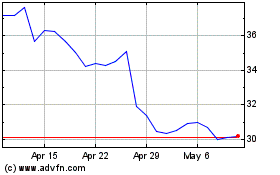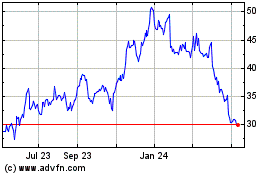Intel Hit as Consumers Flock to Lower-Cost Laptops, Datacenter Chips -- 2nd Update
October 22 2020 - 6:54PM
Dow Jones News
By Asa Fitch
Chip giant Intel Corp. may be seeing an end to the
work-from-home boost it enjoyed during the pandemic, with earnings
hit by consumers gravitating to cheaper laptops and data-center
sales softening.
The company on Thursday said revenue dropped 4% to $18.3 billion
after it enjoyed strong sales in the first half of the year. The
company's bottom line also suffered, with earnings per share
falling to $1.02 in the period from $1.35 a year earlier and
falling short of Wall Street's expectation.
Intel's shares fell more than 10% in after-hours trading.
The company's growth has been principally in areas where prices
are lower, denting profitability, Intel Chief Financial Officer
George Davis said. "We saw much stronger PC demand in the consumer
and education side, which tends to be the more entry-level for PC
notebooks," he said.
For many tech companies, the pandemic has been a boon as
customers invested in equipment and software to enable remote work
and schooling. PC shipments in the U.S. were the highest in a
decade in the third quarter. Cloud computing providers such as
Amazon.com Inc. and Microsoft Corp. have also seen strong demand
for their services as companies embrace tools to facilitate
distributed working.
Mr. Davis said Intel's cloud business had performed well, though
could moderate in the current quarter as customers absorb a
prolonged spending spree. He also said demand in the third quarter
among other kinds of customers that operate datacenters --
companies and governments -- fell 47% after an increase in the
first half of the year.
That spurred a 7% drop in Intel's data-center revenue to $5.9
billion, the company said, falling short of what analysts surveyed
by FactSet forecast. Revenue for the personal-computer-focused
business rose 1% to $9.8 billion. The company's memory division,
most of which it agreed this week to sell to South Korea's SK Hynix
Inc. for $9 billion, also reported lower sales.
Growing production volumes on a new generation of advanced chips
that are more costly to produce put another squeeze on profit
margins, Mr. Davis said during a call with analysts.
Although the results missed Wall Street's bottom-line forecast
of per-share earnings of $1.04, they beat the top-line projection.
Analysts projected sales of around $18.24 billion.
Despite the mixed results, the company raised its full-year
guidance, predicting its top line would increase 5% this year and
reach $75.3 billion, a record. Intel now projects $4.55 in earnings
per share for the year. It previously forecast $75 billion in sales
and $4.53 in earnings per share.
"We're forecasting growth and another record year, even as we
manage through massive demand shifts and economic uncertainty,"
Chief Executive Bob Swan said in a statement.
The changing demand picture represents another challenge for a
company already navigating an intensifying competitive landscape
and in-house chip production problems.
The company is facing stiff competition from Advanced Micro
Devices Inc., which is chipping away at Intel's historically
dominant market share in central processing units for PCs and
servers. AMD's share of PC CPUs rose to near 20% in the second
quarter, according to Mercury Research. And AMD is in talks to buy
chip maker Xilinx Inc. to become an even-more formidable rival to
Intel.
Nvidia Corp., a chip maker that specializes in graphics
processors, surpassed Intel this year as the largest American
semiconductor maker by market valuation. It has been broadening its
focus by catering to fast-growing artificial intelligence
computation and is seeking to buy mobile-phone chip design giant
Arm Holdings in a $40 billion deal that would be the largest-ever
in the chip business.
Intel also faces manufacturing issues that have bedeviled its
performance. This summer, the company said it had has fallen a year
behind the initial schedule for its so-called 7-nanometer superfast
chips, the next generation of superfast chips with the
tiniest-possible transistors. To continue meeting customers' needs,
Intel may have some future cutting-edge chips produced outside its
own factories, a major shift for the company. That manufacturing
flexibility could start to come into play for Intel in 2023, Mr.
Swan said, although decisions on whether to make those products
externally are yet to be made.
Write to Asa Fitch at asa.fitch@wsj.com
(END) Dow Jones Newswires
October 22, 2020 18:39 ET (22:39 GMT)
Copyright (c) 2020 Dow Jones & Company, Inc.
Intel (NASDAQ:INTC)
Historical Stock Chart
From Mar 2024 to Apr 2024

Intel (NASDAQ:INTC)
Historical Stock Chart
From Apr 2023 to Apr 2024
